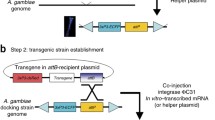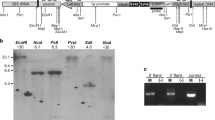Abstract
The main polymorphic system of esterase isoenzymes in adults of the G3 laboratory strain ofAnopheles gambiae consists of two to five major bands of activity per individual. The bands are designated 5S, 5F, 13, 14, and 15. In genetic crosses, the genes which coded for the bands assorted as three codominant alleles, Est A, Est B, and Est C, at a single autosomal locus. Homozygotes for the Est C allele were significantly underrepresented among backcross progeny. The developmental pattern of esterase expression was examined. Esterase gene expression in embryos was first detectable between 2 and 12 hr after oviposition. The initiation or termination of expression of some of the bands corresponded to boundaries between developmental stages. Most of the esterase fractions were not specifically localized within the tissues tested, with the exception of a series of bands which were restricted largely to adult male testes.
Similar content being viewed by others
References
Gilbert, D. G., and Richmond, R. C. (1982). Esterase 6 inDrosophila melanogaster: Reproductive function of active and null males at low temperatures.Proc. Natl. Acad. Sci. USA 792962.
Kimura, M., and Takahata, N. (1983). Selective constraint in protein polymorphism: Study of the effectively neutral mutation model by using an improved pseudosampling method.Proc. Natl. Acad. Sci. USA 801048.
Miles, S. J. (1978). Enzyme variation in theAnopheles gambiae Giles group of species (Diptera: Culicidae).Bull. Entomol. Res. 6885.
Mouches, C., Magnin, M., Berge, J., Silvestri, M., Beyssat, V., Pasteur, N., and Georghiou, G. (1987). Overproduction of detoxifying esterases in organophosphate-resistantCulex mosquitoes and their presence in other insects.Proc. Natl. Acad. Sci. USA 842113.
Narang, S., and Seawright, J. A. (1982). Linkage relationships and genetic mapping inCulex andAnopheles. In Steiner, W. W. M., Tabachnick, W. J., Rai, K. S., and Narang, S. (eds.),Recent Developments in the Genetics of Disease Vectors. Stipes, Champaign, Ill.
Roberts, R. M., and Baker, W. K. (1973). Frequency distribution and linkage disequilibrium of active and null esterase isozymes in natural populations ofDrosophila montana.Am. Natur. 107709.
Sheehan, K., Richmond, R. C., and Cochrane, B. J. (1979). Studies of esterase 6 inDrosophila melanogaster. III. The developmental pattern and tissue distribution.Insect Biochem. 9443.
Steiner, W. W. M., and Joslyn, D. J. (1979). Electrophoretic techniques for the genetic study of mosquitoes.Mosq. News 3935.
Author information
Authors and Affiliations
Rights and permissions
About this article
Cite this article
Vernick, K.D., Collins, F.H., Seeley, D.C. et al. The genetics and expression of an esterase locus inAnopheles gambiae . Biochem Genet 26, 367–379 (1988). https://doi.org/10.1007/BF00554072
Received:
Revised:
Issue Date:
DOI: https://doi.org/10.1007/BF00554072




